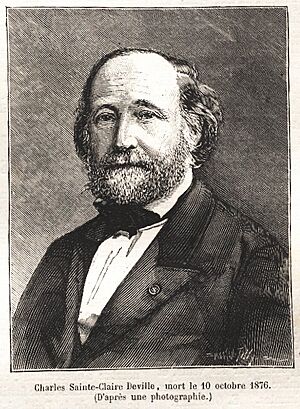Charles Joseph Sainte-Claire Deville facts for kids
Charles Joseph Sainte-Claire Deville (born February 26, 1814 – died October 10, 1876) was a French geologist and meteorologist. Geologists study the Earth's rocks and history, while meteorologists study the weather and atmosphere.
Charles was born in St. Thomas, which is now part of the U.S. Virgin Islands. He was the brother of a well-known chemist named Henri Etienne Sainte-Claire Deville.
Contents
Early Life and Education
Charles Sainte-Claire Deville went to a famous school in Paris called the École des Mines. This school taught him a lot about mining and geology. After his studies, he started working with a very important geologist, Léonce Élie de Beaumont.
He helped Élie de Beaumont teach geology at the Collège de France. This is a very respected college in Paris. Charles worked as an assistant from 1855. Later, in 1874, he took over Élie de Beaumont's position as the main professor of geology.
Scientific Discoveries and Research
Charles Sainte-Claire Deville was very interested in volcanoes. He spent a lot of time studying how volcanoes work and what comes out of them. He was especially curious about the gases that volcanoes release.
He also studied how temperatures change in different places. He looked at temperature changes in the air, which is called the atmosphere. He also investigated how temperatures vary in the ocean. His work helped us understand more about both weather and the Earth's processes.
In 1857, Charles was chosen to become a member of the French Academy of Sciences. This is a very important group of scientists in France. He joined the Academy after another famous scientist, Ours-Pierre-Armand Petit-Dufrénoy, passed away.
Key Achievements and Legacy
In 1852, Charles Sainte-Claire Deville helped start an important group called the Société Météorologique de France. This society focuses on studying weather and climate. He was the very first secretary of this new organization.
Charles was also an adventurous person. In 1859, he became the first person to successfully climb to the very top of Grand Combin. This is a tall mountain, 4314 meters high, located in the Pennine Alps.
For his important work and achievements, he was given a special honor in 1862. He was made an Officier de la Légion d'honneur, which is one of France's highest awards. Charles Sainte-Claire Deville passed away in Paris in 1876.
A special place on the Moon was named after him. It is called the Promontorium Deville. This lunar headland reminds us of his contributions to science.
See also
 In Spanish: Charles Joseph Sainte-Claire Deville para niños
In Spanish: Charles Joseph Sainte-Claire Deville para niños
Images for kids



